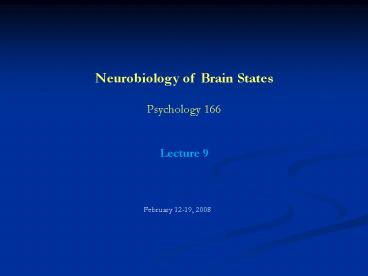Neurobiology of Brain States - PowerPoint PPT Presentation
1 / 27
Title:
Neurobiology of Brain States
Description:
Dorsal Pallium Cerebral Cortex (almost all of it) Medial Pallium Hippocampus. Lateral Pallium Amygdala (part of it) Olfactory Cortex ... – PowerPoint PPT presentation
Number of Views:81
Avg rating:3.0/5.0
Title: Neurobiology of Brain States
1
Neurobiology of Brain States Psychology
166 Lecture 9
February 12-19, 2008
2
Get Involved in Research Early!
Psy 99P/99 (pass/no pass or a grade) Psy 199P/199
(pass/no pass or a grade) Honors
Program Volunteering
3
Brain Viewing Sessions February 13
(Wednesday) 2 PM 3 PM 4 PM Psychology Teaching
Lab, Psychology 3113
4
Hallucinogens
Richard Evans Schultes (1915 2001) The founder
of modern ethnobotany, Professor at Harvard
University.
5
Hallucinogens
All hallucinogens act on receptors of endogenous
neurotransmitters. In other words,
hallucinogens mimic the action of endogenous
brain substances, but they may act in the wrong
place at the wrong time, or their action may be
too strong.
6
Hallucinogens and Serotonin
Synthesized (accidentally) by Albert Hoffman
Bufotenin Found in the skin of some toads (Bufo)
Synthesized in peyote cactus (Lophophora)
Synthesized in more than 75 species of mushrooms
7
Mescaline and Human Culture
5,200 year-old peyote buttons processed by humans
have been excavated from Shumla Caves in
Texas. Most recently, they have been shown to be
an aggregate of ground peyote mixed with other
plant material, i.e., they seem to be
manufactured peyote effigies rather than intact
peyote buttons.
Terry et al. (2006) J. Arch. Sci. 33 1017-1021
8
Bufotenin and Human Culture
Its a spice in witches brew!
9
Ergot Alkaloids and Culture
Ergot is a fungal disease of rye. The fruiting
body of the fungus contains several ergot
alkaloids that are strong hallucinogens and
vasoconstrictors (i.e., they constrict blood
vessels and may cause gangrene at high doses.)
Ergot alkaloids are LSD-like chemicals. They
may be used to treat migraines.
10
Raphe Nuclei
Serotonin-producing cells are located in the
raphe nuclei in the mesencephalon and
metencephalon.
11
LSD and Serotonin (5-HT) Receptors
5-HT1, 5-HT2, 5-HT5-7 receptors are activated by
LSD.
12
Cortical Circuits Affected by Hallucinogens
Cerebral Cortical Layers
Hallucinogens
Apical Dendrite
Axon
Pyramidal Neuron
13
Neurotransmitter Release
Classically, neurotransmitter release is fast and
occurs in sync with the action potential. This
release is calcium-dependent and is known as
synchronous release. It is the only kind of
neurotransmitter release known by most
(well-educated!) students.
14
Neurotransmitter Release
After the fast, synchronous phase of release, the
neurotransmitter may continue to be released for
another 0.5 1.0 seconds. This phase is known
as the asynchronous phase of release. Normally,
this release is also calcium-dependent, but,
unlike in the synchronous phase, calcium ions
(Ca2) may be replaced by STRONTIUM (Sr2).
15
Asynchronous Neurotransmitter Release
Strontium salts are used in fireworks. They give
a brilliant red light.
16
Cortical Circuits Affected by Hallucinogens
Hallucinogens
Apical Dendrite
Axon
By acting on 5-HT2A receptors, hallucinogens
appear to promote the asynchronous phase of
neurotransmitter release. This may lead to
spillover of the neurotransmitter into other,
neighboring circuits.
17
Cortical Areas Affected by Hallucinogens
Medial prefrontal cortex
Most likely, hallucinogens affect many cortical
areas. The medial prefrontal cortex may be one
of the especially important areas.
18
Is There a Relationship Between Hallucinogens
and Synesthesia?
Test for Synesthesia
S2a 5-HT2A
19
European Hexing Herbs A Non-Serotonergic
Approach to Visions
20
European Hexing Herbs A Non-Serotonergic
Approach to Visions
Witches Brew (European Cuisine)
Deadly Nightshade (Atropa)
Henbane (Hyoscyamus)
Mandrake (Mandragora)
21
European Hexing Herbs A Non-Serotonergic
Approach to Visions
Mandrake
22
European Hexing Herbs A Non-Serotonergic
Approach to Visions
Hallucinogenic effects of these plants are
induced by (mostly) scopolamine. Scopolamine is
an antagonist of some acetylcholine (Ach)
receptors. More specifically, it blocks
muscarinic Ach receptors.
23
The Basal Nucleus and Septal Nuclei
Acetylcholine-producing cells are located in the
basal nucleus (of Meynert it is not a basal
ganglion!) and in the septal nuclei in the
telencephalon. (You can ignore a few other
nuclei shown in the diagram.)
24
The Basal Nucleus and Septal Nuclei
Dorsal Pallium
Medial Pallium
Pallium
Lateral Pallium
Subpallium
Pallidum
Septum
Striatum
Dorsal Pallium ? Cerebral Cortex (almost all of
it) Medial Pallium ? Hippocampus Lateral
Pallium ? Amygdala (part of it) Olfactory
Cortex Striatum ? Amygdala (part of it) Basal
Ganglia Pallidum ? Basal Ganglia, Basal
Nucleus Septum ? Septal nuclei
25
The Basal Nucleus and Septal Nuclei
- The major targets of acetylcholine-producing
cells are - Cerebral Cortex
- Hippocampus
- Amygdala
Based on this, what symptoms scopolamine is
likely to induce?
26
Scopolamine
Scopolamine induces the prototypical state of
delirium.
27
Scopolamine
Angels Trumpet (Datura) also contains
scopolamine.































